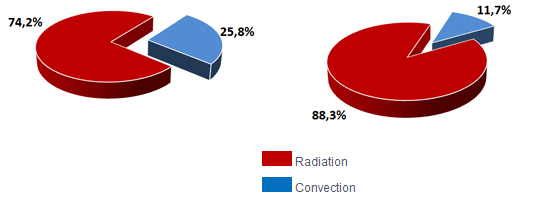The principle of radiant heating Bilux
With convection heating, the heating element warms the air which then subsequently spreads and transfers the heat during circulation along the surface of heated objects (walls, furniture…). From the viewpoint of the ratio of transferred heat, the radiant component is minimal in this system. In the case of radiant heating, the ratio is the opposite – the radiation doesn’t heat the air (it passes freely through it) and the distribution of heat takes place mainly via radiation. The radiant flow is partially reflected (approx. 15%) when it reaches objects (walls, floor, furniture), but most of it (approx 85%) is absorbed by the objects which it reaches. Here, the radiant energy changes into heat energy – the objects warm up. Thanks to the increased temperature of the objects (the heating of the objects) compared to the air temperature, the heat is subsequently taken away by convection – air is heated from the object. This principle is also called infrared heating.
| The ratio of heat distribution from BILUX panels | |
| BILUX low-temperature panel | BILUX high-temperature panel |


| convection heating | BILUX radiant panels |
The intensity of radiation is mainly affected by the surface temperature – the higher it is, the less heat (proportionally) is conveyed by convection. The flowing air doesn’t manage to cool the surface and the radiant component increases. This is clear in the case of high-temperature panels where the radiation ratio is greater thanks to the higher surface temperature. Therefore, the location of the heater influences the proportion of the radiant component. A radiant panel placed in a horizontal position under the ceiling will transfer most of the energy via radiation because the air cannot circulate. However, the ratio of convection will increase significantly if the same panel is placed in a vertical position – the air heated from the surface of the heater will start to go up and natural circulation is created.
The following advantages of this system result from the above-mentioned principle:
- a flow of heat is emitted from the surface of the radiant panel; the majority of its spectrum lies in the zone of wavelengths greater than 5 micrometers and it is absorbed by the surface of human body to a large degree. Therefore, heating occurs according to a similar principle as in the case of objects
- in the case of the heating of objects and people up to 20-22°C using a radiant flow, it is already possible to ensure thermal comfort at air temperatures of 18-19 °C, which results in an energy saving of at least 18 — 24%
- in certain applications, radiant heating panels can be used for the targeted warming of people in an indoor area– large halls, workshops, warehouse stores or for example benches in churches – and achieve more than 50% savings on heating costs in contrast with standard methods of heating such areas – this method is known as zone heating
- it is possible to achieve a significantly more even distribution of temperatures in the vertical profile – a difference of 1-2°C between the floor and the ceiling (for convection heating, a difference of 1°C per 30-50 cm of height is reported)
- as a result of the lowered circulation – the whirling of air in the room – the swirling of dust particles is also limited and thus the danger of the possible occurrence of various diseases – asthma, inflammations of the mucous membranes etc.
- thanks to the increased temperature of the walls, the possibility of the occurrence of surface condensation is lowered; air humidity isn’t decreased significantly
- with radiant flow, i.e. radiation with wave lengths of larger than 3µm, glass is not transparent (permeable to heat) and so there are no radiant flow losses through glass panes
- BILUX radiant heating panels don’t require any maintenance